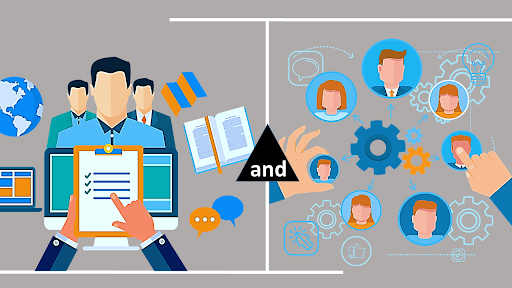Alternative Staffing vs. Traditional Hiring: Which Is Right for Your Business?
- Prachi Shah
- December 6, 2024
- 5 Minute Read

Hiring the right people is like assembling a puzzle—you need the perfect fit to bring the bigger picture to life. With rapidly evolving business needs, this task is no longer just about selecting between two candidates; it’s about choosing between two staffing solutions: alternate staffing and the traditional hiring process. Each offers unique benefits, challenges, and opportunities, making the decision both exciting and critical for businesses.
Hiring strategies have grown beyond conventional boundaries. Businesses now seek flexibility, scalability, and efficiency in hiring. Moreover, research shows that companies offering remote flexibility experience a 40% increase in high-performing employees due to empowered work models. Choosing the right one can make or break your project timelines, budgets, and employee satisfaction levels. But how do you decide? Let’s take a deeper look.

Importance of Choosing the Right Hiring Model
Every business faces resource constraints, whether a bootstrapped startup or a corporate giant. Making a hiring decision isn’t just about filling roles; it’s about meeting business goals sustainably. Choosing the wrong model can lead to the following:
- Missed deadlines
- Overspending on talent
- Misalignment with company culture
In contrast, the right approach can help you hire remote talent, hire IT talent, or build a solid in-house team, depending on your business priorities.
Understanding Alternative Staffing
Alternate staffing involves hiring talent in a flexible, project-based, or non-traditional way. Forget the 9-to-5 office setup; this model embraces freedom for both businesses and workers. It leverages the gig economy, remote work trends, and short-term contracts.
Key Features:
- Flexibility in work hours and contracts
- Cost-effective staffing solutions
- Quick access to a global talent pool
Examples of Alternative Staffing Models
- Freelancers: Independent professionals hired on a per-project basis. Think writers, graphic designers, and developers.
- Remote Teams: Fully remote employees or virtual teams working across time zones.
- Contract Workers: Specialists brought in for a specific task or duration, like consultants or seasonal staff.
Benefits of Alternative Staffing
- Cost Savings: Pay only for what you need—no long-term obligations.
- Access to Expertise: Hire IT talent or niche professionals with highly specialised skills.
- Scalability: Scale up or down without the logistical challenges of layoffs or new hires.
- Global Reach: Access talent from anywhere in the world.
Platforms That Simplify Hiring Remote Talent
Several platforms are changing the way businesses access global talent pools. These make hiring remote talent as seamless as ordering your favourite coffee.
- Toptal: Known for screening top-tier freelancers in fields like tech, design, and finance, Toptal connects you with world-class talent.
- Uplers: A platform that helps businesses find skilled remote professionals in areas like web development, marketing, and design.
- Upwork: A massive marketplace for freelancers across almost every industry, Upwork allows you to hire talent for everything from web development to marketing.
- Arcdev: If you’re looking to hire IT talent, Arcdev is your go-to platform, specializing in finding remote software developers.
Exploring Traditional Hiring
The traditional hiring process is the classic approach of bringing full-time, in-house employees into your company. This method focuses on long-term relationships and cultural alignment.
Key Characteristics:
- Fixed working hours and salaries
- Employment benefits and perks
- In-person collaboration
Examples of Traditional Hiring Models
- In-House Teams: Employees working from a company office.
- Long-Term Employees: Staff hired with the expectation of multi-year tenure.
Advantages of Traditional Hiring
- Cultural Alignment: Employees align with company values over time.
- Long-Term Productivity: Full-time workers develop a deep understanding of business goals.
- Team Collaboration: In-person interactions often foster better synergy.
- Stability: Predictable costs and employee retention.
Comparative Analysis: Alternative Staffing vs. Traditional Hiring

When choosing between staffing vs. hiring, here’s how the two stack up:
1. Cost Implications
- Alternative Staffing: Lower overheads, no benefits, and pay-as-you-go models.
- Traditional Hiring: Higher costs due to benefits, training, and long-term commitments.
2. Flexibility and Scalability
- Alternative Staffing: Perfect for fluctuating workloads and short-term projects.
- Traditional Hiring: Ideal for steady, long-term needs but less adaptable.
3. Skill Availability and Specialization
- Alternative Staffing: Access global talent for niche expertise (e.g., hire IT talent).
- Traditional Hiring: Limited to local talent but better for multi-skill roles.
4. Onboarding and Training Requirements
- Alternative Staffing: Minimal onboarding; they hit the ground running.
- Traditional Hiring: Time-consuming training but results in deeper integration.
5. Long-Term Business Goals Alignment
- Alternative Staffing: Best for short-term or experimental projects.
- Traditional Hiring: Aligns well with long-term goals and stability.
Factors to Consider When Choosing a Hiring Model
Choosing the right model involves weighing these factors:
- Business Size and Industry: Startups may prefer alternate staffing, while larger firms lean towards traditional models.
- Budget Constraints: Tight budgets favour freelancers; established businesses can invest in full-time roles.
- Project Duration and Complexity: Short, specialised projects suit freelancers; long-term needs call for permanent staff.
- Team Dynamics and Culture: Need a cohesive, collaborative culture? Traditional hiring may work better.
Hybrid Approaches: The Best of Both Worlds
Combining Alternative and Traditional Models
Hybrid staffing allows businesses to combine both approaches. For example, they can hire a core in-house team and complement it with freelancers for peak workloads or specialised tasks.
When and How to Use a Hybrid Approach:
- Combine remote developers from Arcdev with in-house project managers.
- Use Upwork for one-off creative projects while maintaining a steady IT department.
- Scale your team during seasonal demand with Uplers contract talent
Conclusion
Selecting the correct staffing model depends on organisational requirements, size, and objectives. So, whether opting for alternative staffing or traditional hiring, there’s no one-size-fits-all solution. But one thing is clear — the staffing world is growing, and your business should evolve with it.
Key Takeaways
- Alternative staffing provides flexibility, saves money, and allows for access to specific skills, while traditional hiring offers stability, ongoing service, and a committed team.
- Think about using hybrid methods to benefit from both long-term employees and short-term specialists.
Ultimately, the key is to choose an option that supports your company’s goals and keeps you ahead in today’s rapidly expanding market.
Frequently Asked Questions
What is alternative staffing?
Ans: Alternative staffing is a flexible hiring procedure involving freelancers, remote teams, or contract workers rather than full-time, in-house workers
What is the difference between alternate staffing and traditional hiring?
Ans: Alternate staffing is project-based and flexible, while standard hiring concerns long-term commitments and fixed roles.
What’s the best platform to hire remote talent?
Ans: Platforms like Upwork, Toptal, and Arcdev provide a diverse spectrum of remote talent, helping companies hire IT talent and other experts for project-based tasks.
Can I mix both models?
Ans: Absolutely. Many organisations leverage a hybrid approach to incorporate the strengths of both models. By assessing the pros and cons and knowing your distinctive requirements, you can prepare a hiring strategy that aligns exceptionally with your enterprise goals.

Thank you for submitting the details!
We will keep your information safe. Feel free to contact us with any questions at hello@uplers.com
Please check your email for next steps shared by Robert.

















